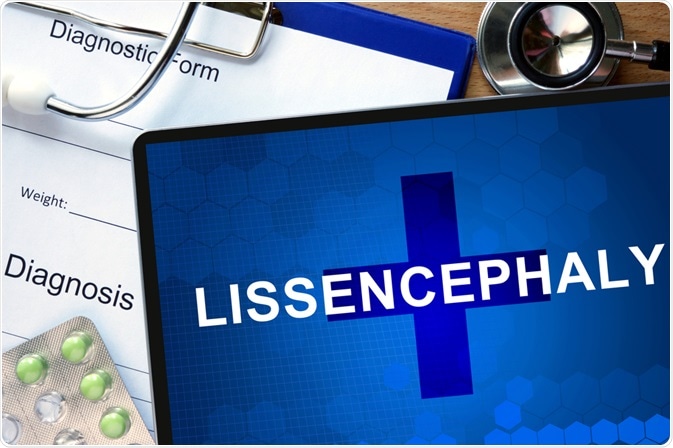Lissencephaly (colloquially known as smooth brain) is a rare developmental disorder of the brain cortex due to impaired neuronal migration between the 3rd and 4th months of human gestation. The condition can appear isolated or associated with diverse phenotypes such as Miller-Dieker or Walker-Warburg syndrome.

Lissencephaly. Image Credit: Vitalii Vodolazskyi/Shutterstock.com
Good knowledge of the normal ultrasonographic and magnetic resonance imaging appearance of the cerebral cortex at various stages of fetal gestation is pivotal for the early recognition of this disorder. Diagnosis should also be considered in children with a delay in development and facial dysmorphism.
Clinical presentation
Patients with lissencephaly often experience psychomotor development delay, mental retardation, muscle spasticity, failure to thrive, dysmorphism, microcephaly, as well as poor performance in school. Other signs of the disease can be craino-facial abnormalities, hampered swallowing and eating, and anomalies of the fingers or toes.
Seizures or infantile spasms can also occur (most frequently within the first year of life), and epilepsy associated with lissencephaly is usually resistant to conventional treatment. Severe delay in cognitive development may also ensue, which is nearly a universal feature of classical lissencephaly.
Respiratory illnesses and periodic aspiration are common, thus many infants with lissencephaly that seem normal at birth, present with immediate respiratory problems. Repeated bouts of pneumonia from swallowing food down an airway and into the lungs are commonly observed.
Furthermore, feeding difficulties include gagging, choking, or regurgitating foods or liquids. These symptoms often worsen later in the course of disease (most notable after 3 years of age), and a large number of children also have gastroesophageal reflux.
Ocular abnormalities and encephalocele are present in certain cases of cobblestone dysplasia or type II lissencephaly, such as Walker-Warburg syndrome. Muscle weakness and apnea are also commonly observed, but it must be noted that weakness of the muscles can be substituted with excessive muscle tension or spasticity over time.
Diagnostic approach
The diagnosis of lissencephaly is established via neuroimaging during or soon after birth with the aid of computed tomography or magnetic resonance imaging. During the third trimester of pregnancy, ultrasound examination can be a valuable tool to demonstrate a reduction or an absence of cerebral sulci.
Nevertheless, milder degrees of cerebral involvement and focal disease can be cumbersome to detect at prenatal ultrasound examination, and magnetic resonance imaging is often not pursued if ultrasound findings are normal. Furthermore, even if magnetic resonance is performed, the diagnosis highly depends on the pregnancy period.
The diagnosis may also be suggested by ventriculomegaly (surplus of fluid in the lateral ventricles within the developing brain) and increased subarachnoid space. Some forms of the disease are also associated with microcephaly, which is another feature that can be easily detected during the final three months of pregnancy.
When lissencephaly is suspected, chorionic villus sampling (an accurate antenatal screening test) can reveal certain disease types with known genetic mutations. Mutation analysis can be performed to look for specific errors in the sequence of LIS1 and DCX genes, which are responsible for 75% of classic isolated lissencephaly cases.
In addition to all the aforementioned diagnostic techniques, a careful clinical examination and evaluation by a medical geneticist are needed in order to confirm the diagnosis. Genetic counseling should follow as families should be informed about the inheritance pattern and the likelihood of the condition recurring in future births.
References:
Further Reading
Last Updated: Mar 24, 2021